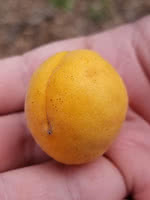Mon-Fri 9am - 5pm Mountain time
Manchurian Apricot vs Ottawa 3 Rootstock
Prunus armeniaca var. mandshurica
Robin crab X Malling 9 ((Malus baccata X Malus sylvestris) x Malling 9)
NOT AVAILABLE THIS SEASON - MIGHT RETURN
Manchurian Apricot is a winter-hardy relative of the native plum. This tree can stand some drought, but will not handle standing water or saturated moist soils. It can be used in shelterbelts, hedges, or as an ornamental. Manchurian Apricot will also attract songbirds, rabbits, and other rodents if left uncontrolled.
This tree will produce fruit once it reaches maturity at between two and five years old. Other famous cultivars of Manchurian Apricot include Scout Apricot, Moongold, and many more.
Ottawa 3 Rootstock is the most dwarfing rootstock to come out of the cold-hardy breeding program by the Agricultural Canada Research Station in Ottawa. It produces dwarf to semi-dwarf trees that are 45-55% of standard size. Due to its superior hardiness, it is well adapted to Canadian weather conditions.
It originates from Malling 9 (M.9) and the Robin Crab and is considered more dwarfing than Malling 26 (M.26) and more vigorous than Malling 9. Ottawa 3 Rootstock is very productive and bears fruit early, often requiring structural support when young.

